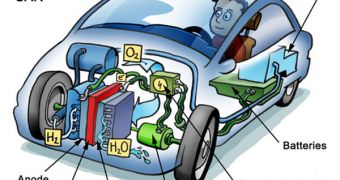Scientists at the Georgia Institute of Technology (Georgia Tech) have recently announced the development of a new, innovative type of ceramic that, apparently, has the ability to be a major contributor to improving the hydrogen-fuel cell battery technology and bring about the new era of all-electric cars. The new material, called Barium-Zirconium-Cerium-Yttrium-Ytterbuim Oxide (BZCYYb), is, apparently, able to make solid oxide fuel cells less costly and more efficient, while at the same time increasing their life span considerably.
The thing about the new ceramic material is that not even its inventors are exactly sure how it functions, Gas 2.0 reports. They know, however, that it does, and they plan to implement it in existing technologies as soon as possible. If future innovations make solid oxide systems more affordable, then the new ceramic could lead to the complete removal of precious metals such as platinum from hydrogen fuel cells, which will make them more environmentally friendly, and also a lot more cheaper. Advances in nanotechnology have already led to less platinum being needed in new-generation fuel cells, but experts are trying to eliminate it altogether.
One thing preventing solid oxide technology from going out into mass production is heat. The yttria-stabilized zirconia (YSZ) anodes that are being used as an integrated part of it are excellent catalysts and conductors, but they lose conductivity at low temperatures. And, by low, we mean less than 1,000 degrees Celsius. Keeping such a high temperature inside a car engine is, naturally, close to impossible. The multitude of innovations needed to make a YSZ-based fuel cell work leads to higher costs, less durability, and an overall lower efficiency.
On the other hand, BZCYYb can maintain its conductivity at temperatures as low as 500 degrees Celsius, which means that only half of the complex systems needed for YSZ are needed for the new ceramic. Essentially, this translates into a 200-percent increase in efficiency and durability, the Georgia Tech team believes. The experts have yet to pinpoint what exactly it is that causes the new ceramic to behave in this manner, but further studies could lead to even more advanced materials to be used in tomorrow's fuel cells.

 14 DAY TRIAL //
14 DAY TRIAL //